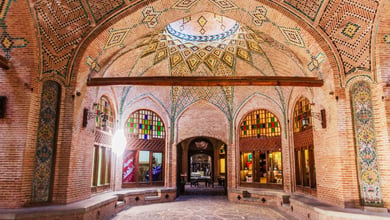Persian Caravanserai: Roadside Inns on Iran’s Silk Road
Caravanserais of Iran: A Journey Through Time and Tradition on the Ancient Roads

Caravanserais, also known as kārvān-sarā or sarāy, are a testament to the rich cultural and architectural history of Persia. Originating from the Persian words ‘kārvān’ (caravan) and ‘Sarāy‘ (house), these structures have historically functioned as inns along ancient roadways across the Iranian plateau, offering accommodation and safety to travelers journeying along these extensive routes.
On September 17, 2023, during the 45th session of the UNESCO World Heritage Committee, convened in Riyadh, Saudi Arabia, a meticulous evaluation was conducted, resulting in the meticulous selection of 54 historical caravanserais situated in 24 provinces throughout Iran. These exceptional sites were officially inscribed onto the prestigious UNESCO World Heritage List.
Contents
UNESCO Lists 54 Persian Caravanserais
On September 17, 2023, during the 45th session of the UNESCO World Heritage Committee, convened in Riyadh, Saudi Arabia, a meticulous evaluation was conducted, resulting in the meticulous selection of 54 historical caravanserais situated in 24 provinces throughout Iran. These exceptional sites were officially inscribed onto the prestigious UNESCO World Heritage List.
| ID | Name of Caravanserai | Coordinates | City |
| 1 | Deyr-e Gachin Caravanserai | N35 3 30.07 E51 25 12.49 | Tehran – Qom |
| 2 | Noushirvān Caravanserai | N35 46 14.63 E53 43 56.54 | Semnan |
| 3 | Āhovān Caravanserai | N35 46 13.94 E53 43 48.52 | Semnan |
| 4 | Parand Caravanserai | N35 27 29.62 E50 58 28.55 | Tehran |
| 5 | Robāt-e Sharaf Caravanserai | N36 15 59.65 E60 39 18.58 | Mashhad |
| 6 | Anjireh Ājori Caravanserai | N32 9 11.68 E54 28 37.59 | Isfahan |
| 7 | Anjireh Sangi Caravanserai | N32 9 43.96 E54 29 2.54 | Isfahan |
| 8 | Abbās Ābād Tāybād Caravanserai | N34 59 45.37 E60 43 6.12 | Taybad |
| 9 | Jamāl Ābād Caravanserai | N37 16 18.89 E47 50 35.16 | Tabriz |
| 10 | Qelli Caravanserai | N37 9 11.86 E56 55 14.67 | Gorgan |
| 11 | Fakhr-e Dāvūd Caravanserai | N35 59 59.59 E59 18 48.55 | Mashhad |
| 12 | Sheikhali Khān Caravanserai | N32 52 5.37 E51 22 13.45 | Isfahan |
| 13 | Maranjāb Caravanserai | N34 17 56.89 E51 48 44.59 | Kashan |
| 14 | Amin Ābād Caravanserai | N31 40 21.7 E52 4 6.41 | Yazd |
| 15 | Gabr Ābād Caravanserai | N33 46 6.96 E51 29 22.29 | Qom |
| 16 | Mahyār Caravanserai | N32 15 54.06 E51 48 35.04 | Isfahan |
| 17 | Gaz Caravanserai | N32 48 33.69 E51 36 33.56 | Isfahan |
| 18 | Kūhpāyeh Caravanserai | N32 42 48.35 E52 26 8.83 | Isfahan |
| 19 | Mazinān Caravanserai | N36 18 28.36 E56 48 23.19 | Semnan |
| 20 | Mehr Caravanserai | N36 17 4.53 E57 8 36.97 | Mashhad |
| 21 | Zafarāniyeh Caravanserai | N36 9 56.59 E58 5 10.43 | Mashhad |
| 22 | Fakhr Ābād Caravanserai | N34 44 40.69 E58 3 19.39 | Birjand |
| 23 | Sarāyān Caravanserai | N33 51 19.03 E58 31 4.86 | Birjand |
| 24 | Qasr-e Bahrām Caravanserai | N34 45 55.01 E52 10 37.69 | Isfahan |
| 25 | Mayāmey Caravanserai | N36 24 33.07 E55 39 11.88 | Semnan |
| 26 | Abbās Ābād Caravanserai | N36 21 40.39 E56 23 16.35 | Sari |
| 27 | Miāndasht Caravanserai | N36 25 41.27 E56 3 38.08 | Gorgan |
| 28 | Zeynoddīn Caravanserai | N31 24 42.69 E54 42 24.67 | Yazd |
| 29 | Meybod Caravanserai | N32 13 40.53 E54 0 33.1 | Yazd |
| 30 | Farasfaj Caravanserai | N34 29 16.68 E48 16 58.76 | Tuyserkan |
| 31 | Īzadkhāst Caravanserai | N31 30 48.11 E52 7 59.54 | Shiraz |
| 32 | Bisotūn Caravanserai | N34 23 04.32 E47 26 05.76 | Kermanshah |
| 33 | Ganjali Khān Caravanserai | N30 17 27.44 E57 4 44.17 | Kerman |
| 34 | Yengeh Emām Caravanserai | N35 56 10.63 E50 43 10.64 | Tehran |
| 35 | Khājeh Nazar Caravanserai | N38 58 38.8 E45 34 37.1 | Tabriz |
| 36 | Goujebel Caravanserai | N38 20 38.02 E46 51 48.06 | Tabriz |
| 37 | Sāeen Caravanserai | N38 0 3.76 E47 52 53.71 | Ardabil |
| 38 | Titi Caravanserai | N37 2 41.19 E49 54 8.05 | Rasht |
| 39 | Dehdasht Caravanserai | N30 47 17.53 E50 33 41.49 | Yasuj |
| 40 | Khoy Caravanserai | N38 27 57.6 E44 37 24.7 | Khoy |
| 41 | Bāgh-e Sheikh Caravanserai | N34 59 26.99 E50 26 49.04 | Qom |
| 42 | Neyestānak Caravanserai | N32 58 16.34 E52 47 57.71 | Isfahan |
| 43 | Chehel Pāyeh Caravanserai | N31 56 24.04 E57 8 25.47 | Kerman |
| 44 | Khān Caravanserai | N33 21 58.97 E56 4 13.49 | Yazd |
| 45 | Deh Mohammad Caravanserai | N33 59 29.62 E56 58 45.04 | Yazd |
| 46 | Tāj Ābād Caravanserai | N34 52 35.88 E48 13 14.62 | Hamedan |
| 47 | Chāh kūrān Caravanserai | N31 34 9.6 E56 51 0.61 | Yazd |
| 48 | Kharānaq Caravanserai | N32 20 41.81 E54 40 4.74 | Yazd |
| 49 | Rashti Caravanserai | N32 26 26.6 E53 37 51.79 | Isfahan |
| 50 | Borāzjān Caravanserai | N29 16 1.61 E51 12 29.73 | Bushehr |
| 51 | Chameshk Caravanserai | N33 14 16.64 E48 12 40.81 | Khorramabad |
| 52 | Afzal Caravanserai | N32 2 38.26 E48 51 7.66 | Ahvaz |
| 53 | Bastak Caravanserai | N27 11 54.6 E54 22 33.5 | Bandar Abbas |
| 54 | Saʿadossaltaneh Caravanserai | N36 16 9.46 E50 0 2.55 | Qazvin |
The earliest caravanserais trace back to the Achaemenid Empire’s Royal Road, a major ancient highway stretching 2500 kilometers from Sardis to Susa. Historical records, such as Herodotus’ writings, indicate the existence of these structures as crucial elements along this road, providing safe havens in otherwise perilous journeys.
Caravanserais stand out as some of the largest types of Islamic buildings. Their significance lies not just in their size but in their role as essential rest stops for merchants and pilgrims facing harsh travel conditions. These establishments ensured the safety of both travelers and their animals, providing necessities like food and water.
In Persian architecture, caravanserais are renowned for bridging civilizations and cultures. They served more than just commercial and religious needs; these structures were pivotal in the exchange of culture, science, and various aspects of human civilization. Roads like the Silk Road and the Spice Road were enriched by the presence of caravanserais, contributing significantly to the spread of knowledge, beliefs, and religions.
Architecturally, Iranian caravanserais were mostly rectangular with a central courtyard, a singular entrance, and adequate fortification when necessary. This layout, possibly borrowed from the Achaemenid period’s Chāpār-khāneh, evolved over centuries, each era adding its touch to the design. The typical form included a courtyard surrounded by chambers for rest and additional halls for pack animals.
The diversity in the architectural styles of these caravanserais is vast, with variations developing in subsequent periods. Their construction continued up until the early 20th century, representing a significant, unbroken tradition within Iranian architecture. These structures were often built through donations or endowments, reflecting the Islamic ethos of caring for travelers, especially those unable to afford their travel expenses.
Today, caravanserais remain iconic symbols of Persian architectural and cultural heritage, standing as historical markers of a time when they were pivotal in supporting the journeys of travelers across ancient Persia.
Architectural Design and Features

Persian Caravanserais, historically dotted across various provinces like Isfahan, Khorasan, and Yazd, exhibit a fascinating blend of function and form. These structures were strategically placed, ensuring no two caravanserais were more than 40 kilometers apart – the maximum distance a caravan could travel in a day. This meticulous planning reflects not just architectural foresight but also a deep understanding of the needs of travelers and their caravans.
Unique Architectural Elements
The quintessential design of a Persian Caravanserai centers around a rectangular structure enclosing a central courtyard. This design was not only practical for accommodating travelers and their animals but also effective in providing security against potential threats like wild animals and bandits. The central courtyard, a common feature in these caravanserais, served as a communal area where travelers could rest, exchange stories, and trade goods.
The entrance to a caravanserai was typically emphasized by a projecting block, giving it a distinct architectural presence. Once inside, the courtyard was often surrounded by chambers intended for rest. Behind these chambers were additional halls for storing pack animals and goods. This layout ensured a seamless blend of hospitality and utility, critical for the survival of travelers in the harsh landscapes of ancient Persia.

Moreover, the architectural variation within these caravanserais was considerable. Over time, each subsequent period in Persian history introduced new elements and styles to their design. Despite these variations, a common theme of robustness and functionality ran through all caravanserais, making them indispensable components of the ancient Persian road networks.
Today, many of these caravanserais have been revitalized for modern use, transforming them into touristic destinations. They continue to serve as vivid reminders of Persian architectural ingenuity and the region’s rich history of commerce and cultural exchange.
Historical Development

The evolution of Persian Caravanserais is a journey through the annals of Persian history, dating back to the Achaemenid Empire. The earliest caravanserais emerged along significant trade routes like the Royal Road, evolving through subsequent eras, each leaving its distinct architectural mark. As trade and commerce flourished, these caravanserais became vital components of the Persian landscape, accommodating the increasing demands of travelers and traders.
The Sassanid period witnessed the expansion of these structures, integrating more complex designs and functionalities. With the advent of the Islamic era, caravanserais continued to evolve, now reflecting the artistic and architectural influences of Islamic culture. This period saw an increase in the number and diversity of caravanserais, with each region developing its unique style, influenced by local climate, culture, and needs.
Influence on Persian Architecture
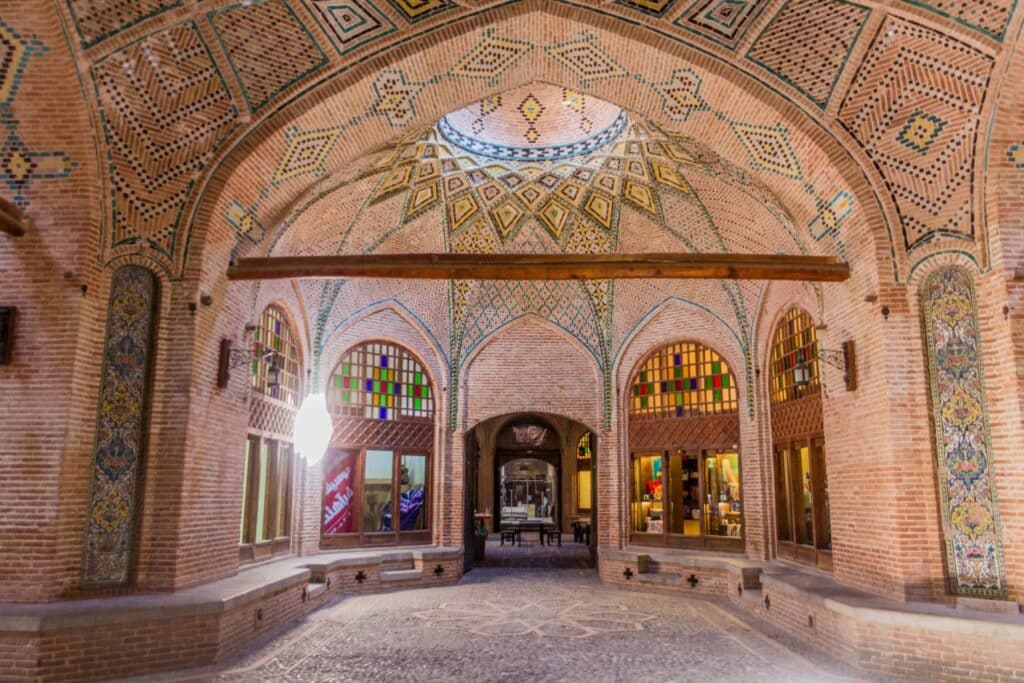
Caravanserais played a significant role in shaping Persian architecture. They were not just functional structures but also represented the artistic and cultural ethos of the times. The architectural elements of caravanserais, such as the central courtyard, iwans (porches), and intricate decorations, influenced other Persian architectural forms, including mosques and palaces.
The use of robust materials, like stone and brick, in their construction, and the implementation of advanced engineering techniques, set a precedent for subsequent Persian architectural endeavors. The layout of caravanserais, with a focus on communal spaces and private chambers, influenced the design of residential and public buildings in Persian cities.
Throughout their history, Persian caravanserais have been more than mere stops along trade routes; they have been centers of cultural exchange, architectural innovation, and hubs of commercial activity. Their evolution mirrors the rich tapestry of Persian history, showcasing the adaptability and ingenuity of Persian architects and builders across different eras.
Today, these caravanserais stand as a testament to Persian architectural brilliance and its ability to blend functionality with aesthetic beauty. As we explore these ancient structures, we are reminded of their pivotal role in the historical and cultural development of Persia.
Caravanserai and Persian Culture

Persian Caravanserais have been pivotal in shaping the trade and commerce landscape of ancient Persia. Strategically located along major trade routes, these structures served as essential rest stops for caravans, facilitating the flow of goods, ideas, and people across vast distances. Their placement was so calculated that no two caravanserais were more than a day’s journey apart, ensuring continuous and efficient movement of trade caravans.
The design of caravanserais, with large courtyards and storage facilities, accommodated not just travelers but also their merchandise and pack animals. This made them critical nodes in the commercial network of Persia, boosting local and regional economies. As trade flourished, so did the caravanserais, evolving to meet the changing needs of commerce and trade.
Significance in Persian Literature

The influence of caravanserais extends beyond their physical structure into the realm of Farsi literature. These caravanserais have been immortalized in Persian poetry and prose, symbolizing the journey of life, the meeting of cultures, and the transient nature of existence. They have been depicted as places of rest and reflection, where travelers from diverse backgrounds converge, share stories, and depart, enriched by their experiences.
In Farsi literature, caravanserais often represent a microcosm of the world, a place where human interactions, with all their complexities and nuances, unfold. They are settings for tales of love, adventure, and philosophical contemplation. The imagery of caravanserais in literature conveys a sense of nostalgia and romanticism, reflecting the Persian appreciation for journey, hospitality, and cultural exchange.
Through their role in trade and their representation in literature, Persian Caravanserais have left an indelible mark on both the economic and cultural history of Persia. They stand as testaments to the region’s rich heritage, embodying the spirit of ancient trade routes and the poetic soul of Persian culture.
Types and Classification
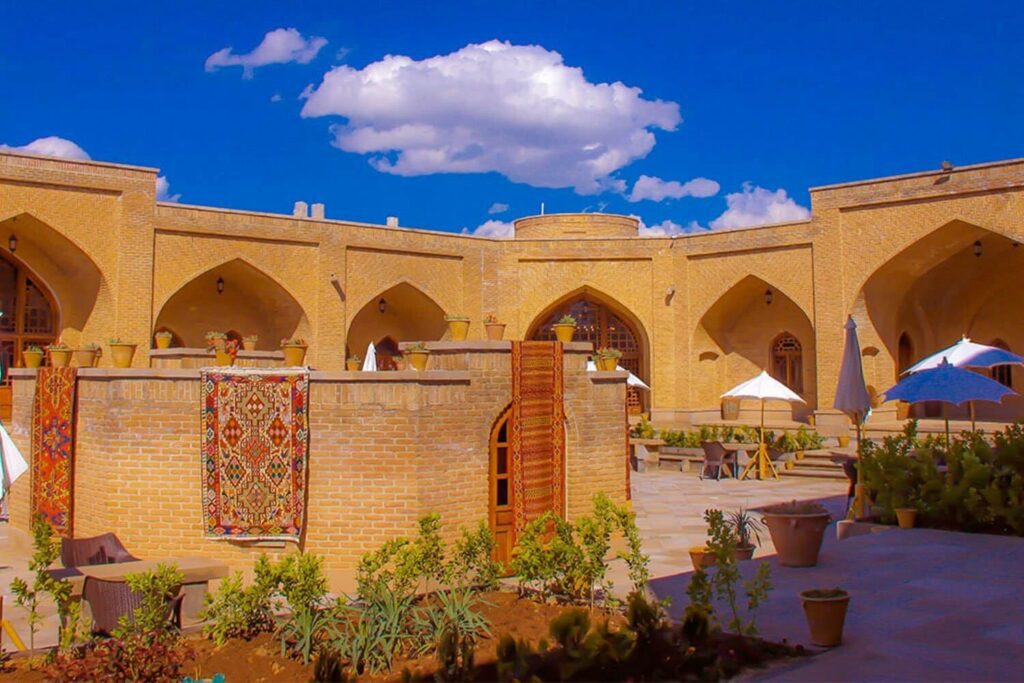
The ancient network of Persian caravanserais, integral to the historic Silk Road, presents a fascinating study in architectural diversity and ingenuity. These structures, more than mere waypoints for weary travelers, were masterpieces of design, tailored to the unique challenges posed by their location and climate.
The categorization of Persian caravanserais reveals a spectrum of architectural and functional diversity. Generally, these can be classified based on factors such as location, ownership, and purpose:
Urban Caravanserais
Located within city precincts, these structures functioned as bustling commercial hubs, often linked with marketplaces and mosques.
Rural Caravanserais
Scattered across remote landscapes, they offered respite and refuge to travelers and merchants on long journeys.
Royal Caravanserais
These were grand structures commissioned by monarchs, reflecting the opulence and grandeur of Persian architecture.
Different Styles Across Iran
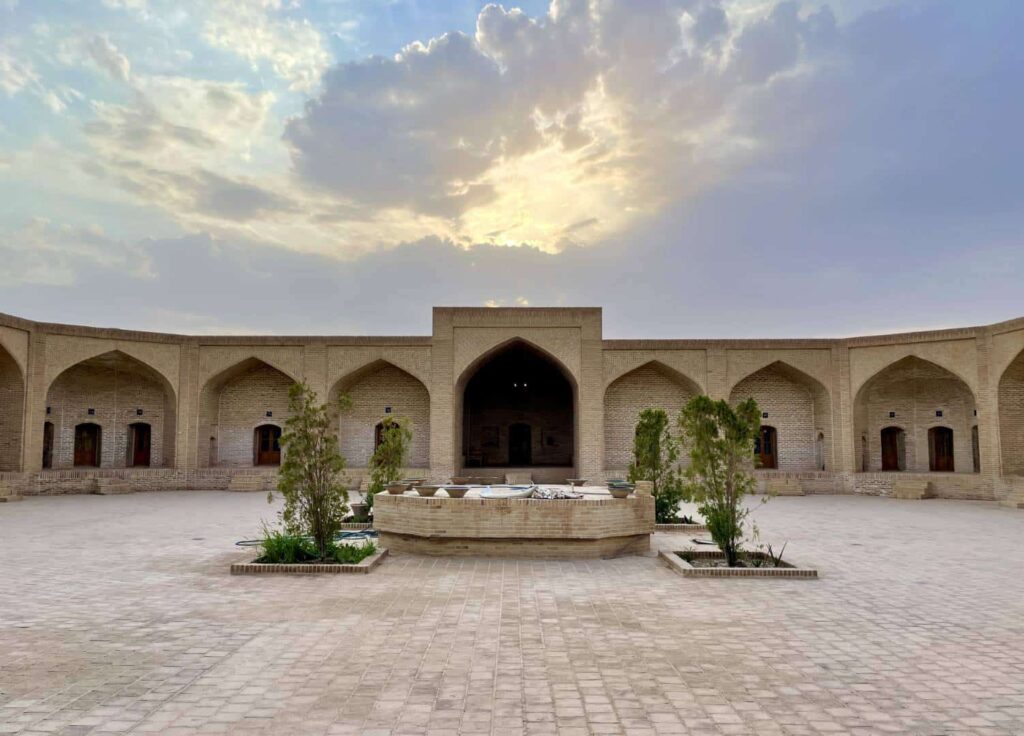
Iran’s vast and varied landscape influenced the architectural styles of caravanserais across different regions:
Desert Caravanserais
In arid landscapes, architects designed caravanserais with thick walls and minimal windows to combat extreme temperatures. Courtyards often featured central pools, providing a much-needed respite from the heat.
Mountainous Caravanserais
In colder, rugged terrains, caravanserais had steep roofs and large courtyards, designed to withstand heavy snowfall and provide shelter from the wind.
Coastal Caravanserais
In these regions, the design incorporated features to combat humidity and provide ventilation, often with high ceilings and open archways.
Influence of Location and Climate on Design

The design of each caravanserai was a direct response to the challenges posed by its environment. This adaptability reflects the resourcefulness of Persian architects:
Hot and Arid Climates
In desert regions, caravanserais were built using mud-brick, which provided excellent insulation. The courtyards were designed to maximize shade, and wind-catchers (badgirs) were often used to cool the interiors.
Cold and Mountainous Regions
Here, the use of stone in construction helped retain heat. The architecture included features like fireplaces and enclosed spaces to provide warmth and shelter from the harsh winter.
Varied Ecosystems
In more temperate climates, the design of caravanserais balanced the need for protection from the elements with the comfort of travelers, integrating aspects from both desert and mountain styles.
Famous Persian Caravanserais
In the heart of Iran’s historic landscape lie the Persian caravanserais, each a storybook of ancient travels and cultural exchanges. These architectural marvels, once the lifelines of the Silk Road, stand as testaments to Iran’s rich history. Let’s embark on a journey through some of the most famous Persian caravanserais, unveiling their unique stories and historical significance.
Deyr-e Gachin Caravanserai

Deyr-e Gachin: Often referred to as the mother of all Iranian caravanserais. Deyr-e Gachin Caravanserai is a historical marvel located in the heart of Kavir National Park, Iran, stands as a testament to ancient Persian architecture and trade. This massive structure, sprawling over an area of approximately 12,000 square meters, is situated on the historic Road to Ray, making it a crucial stop for travelers and traders traversing through ancient Persia.
The caravanserai’s entrance is a striking feature, with its domed ceiling and two-floor structure that includes high Iwāns (porches) and Iwānchehs (small porches), leading to the Hashti (central hall) and corridors that open into a massive, 4600-square-meter, square-shaped central courtyard. This courtyard, designed in a four-Iwāns pattern, is flanked by 36 chambers, each with a vaulted ceiling, a fireplace, and niches.
Behind these chambers lie the stables, equipped with platforms for storing goods and commodities, indicative of the caravanserai’s role in ancient commerce. The southeast side of the building leads to a mosque, thought to be the oldest part of the structure, with four square columns and a prayer niche (mihrab). Additionally, the caravanserai features a Shāh-Neshīn space (royal sitting area) in the north, comprising an open octagon courtyard surrounded by three-door rooms and an octagonal pool, and a bath area accessible via a covered corridor in the southwest.
Architecturally, Deyr-e Gachin showcases four towers at its corners and two additional towers flanking the entrance. Excavations at these towers have unearthed traces of Sassanid architecture, dating the caravanserai’s origins back to the Sassanid period. The primary construction material is brick, chosen due to the unavailability of stone and its better insulation properties. The caravanserai’s decorations are minimal, focusing on geometric designs at the entrance porch and other areas of the building.
A significant feature of Deyr-e Gachin is its large Āb-Anbār (water cistern) with a dome, designed to collect rainwater for consumption, crucial for survival in the desert location. The caravanserai’s long history spans several dynasties, including the Sassanid, Seljuk, Safavid, and Qajar, each contributing to its restoration and preservation. Originally known as Kordshir Fortress, built during the reign of Ardashir I, the founder of the Sassanid dynasty, Deyr-e Gachin is estimated to be about 1800 years old, a magnificent relic of Iran’s rich history.
Robāt-e Sharaf Caravanserai

The Robāt-e Sharaf Caravanserai, a stunning exemplar of Iranian architecture, stands majestically along the historical Silk Road, precisely on the route from Merv to Neyshabour. This caravanserai, a hallmark of the Seljuk period, is not just an architectural wonder but also a testament to the once flourishing trade and the safety of the Khorasan Road. Its location, amidst the “Chekūdār” plain, near the village of Shurlagh and northeast of Mashhad, marks a spot of great historical significance. The craftsmanship and aesthetic appeal of Robāt-e Sharaf are unparalleled, making it an incomparable landmark in the realm of Persian caravanserais.
A closer look at its structure reveals a meticulous adherence to the principles of Iranian architecture, particularly in its design and construction. The caravanserai features two connected courtyards, each embodying the classic four-porch pattern of Seljuk architecture. These courtyards are not just functional spaces but are adorned with intricate and innovative brick designs that grace the facades, porches, arches, niches, and domes. This intricate detailing elevates the structure, giving it the grandeur of a royal mansion. The differentiation in the courtyards’ purposes is fascinating – the first courtyard served as a resting place for ordinary travelers, while the larger, second courtyard catered to the needs of the elite, such as the royal family and rulers, underscoring the social hierarchy of the era.
Parand (Ghalʿe Sangi) Caravanserai
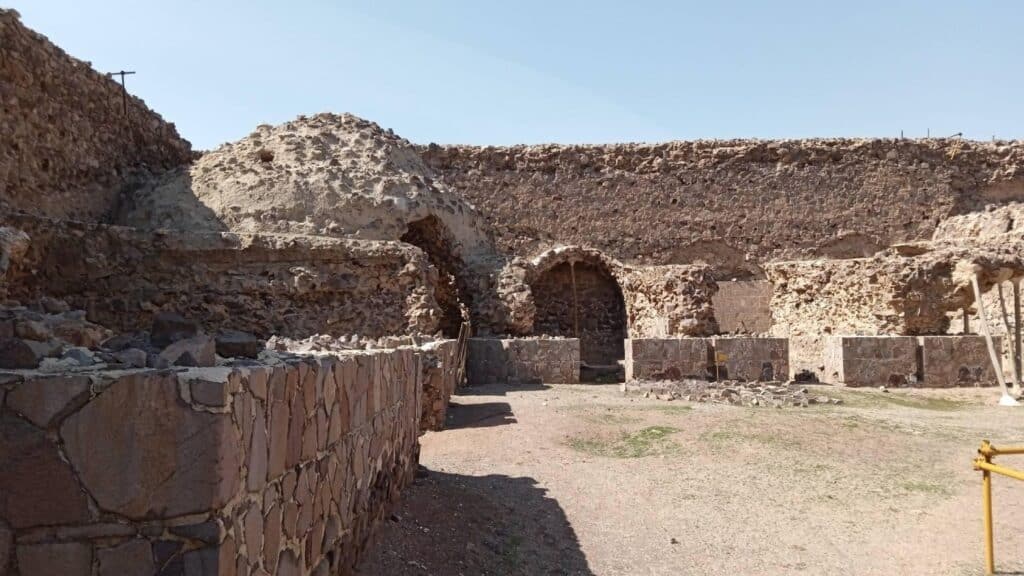
The Parand Caravanserai, also known as Ghalʿe Sangi, is a remarkable relic of the Al-Buyid Dynasty (943-1030 A.D), nestled in the south of Parand city, just 30 km south of Tehran. This caravanserai, which has been a silent witness to centuries of history, is strategically located at km 6 of Robāt Karim to Saveh road. Its precise coordinates are 50°58’28.55″E and 35°27’29.62″N. This historic structure, with its unique architectural style, serves as a gateway to the rich and complex history of the region. The caravanserai’s geographical setting and design elements make it a significant representation of the architectural ingenuity of its era.
This Central Plateau of Iran type of caravanserai showcases a distinct early-Islamic era architecture with a square-shaped structure and the classic four-Iwān pattern. Constructed mainly of stone, the caravanserai’s decorations and layout are reflective of its historical context. The entrance, located on the south side, leads to a porch gate and rooms on the second floor, which feature south-facing windows. This caravanserai’s significance was further recognized in 2003 when it was added to the list of Iranian monuments, prompting urgent restoration efforts and various research projects to gain deeper insights into its history and architecture.
Abbās Ābād Tāybād Caravanserai, Tāybād

The Abbās Ābād Tāybād Caravanserai stands as a proud testament to the rich architectural heritage of Khorasan, reflecting the glory of the Ilkhanate, Teymurian, and Qajar periods. This caravanserai was renowned as one of the most prestigious in the region during its peak, celebrated for its expansive spaces and comprehensive welfare facilities. Its significance is echoed in numerous travelogues and historical texts, underscoring its importance in the annals of Persian history. Constructed primarily of brick, this caravanserai is characterized by a rectangular four-Iwān layout, typical of the architectural style of its era.
Located in a vast plain, 26 km northwest of Taybad city and along the old road to Torbat-e Jam, the Abbās Ābād Tāybād Caravanserai occupies a strategic position at coordinates 60°43’8.46″E and 34°59’45.09″N. This location, on the eastern kingway of ancient Iran, underscores its historical significance, as it facilitated the establishment of numerous facilities in the area. Architecturally, this caravanserai distinguishes itself from common Safavid structures with its large size, central courtyard, and the unique arrangement of its four porches. Notably, it features a columned hall, diverging from the typical Shotor-Khān layout of Safavid caravanserais, making it a special and unique example of its kind.
Zein-o-din Caravanserai
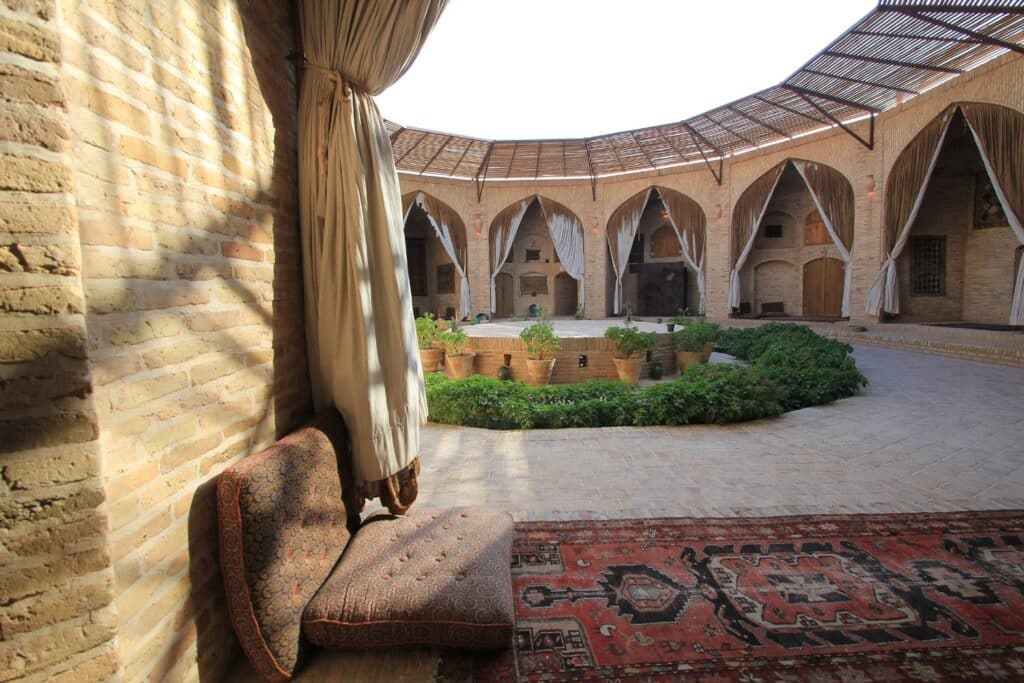
The Zein-o-din Caravanserai, a historical jewel registered in the National Cultural Heritage List in 1972, stands as a magnificent testament to the enduring legacy of Persian architectural excellence. This caravanserai, having undergone continuous conservation and restoration since 1988, embodies a unique blend of traditional craftsmanship and modern facilities. In a significant move in 2001, it was handed over to the private sector for revitalization. This transition transformed the caravanserai into a charming accommodation for tourists, all under the watchful supervision of the Iranian Cultural Heritage, Handicrafts and Tourism Organization (IMCHTH).
This caravanserai’s recognition reached a global scale in 2006 when it received an honorary diploma from UNESCO. This accolade was in recognition of its successful revitalization and the skillful use of traditional construction materials. Today, Zein-o-din Caravanserai boasts the capacity to host one hundred visitors, striking a harmonious balance between its historical authenticity and the integration of modern amenities. This transformation has been done so adeptly that it retains its original charm while offering contemporary comfort. The ongoing conservation and management of the caravanserai are diligently carried out by the Caravanserais Base and the cultural heritage organization of Yazd Province.
Saʿadossaltaneh Caravanserai
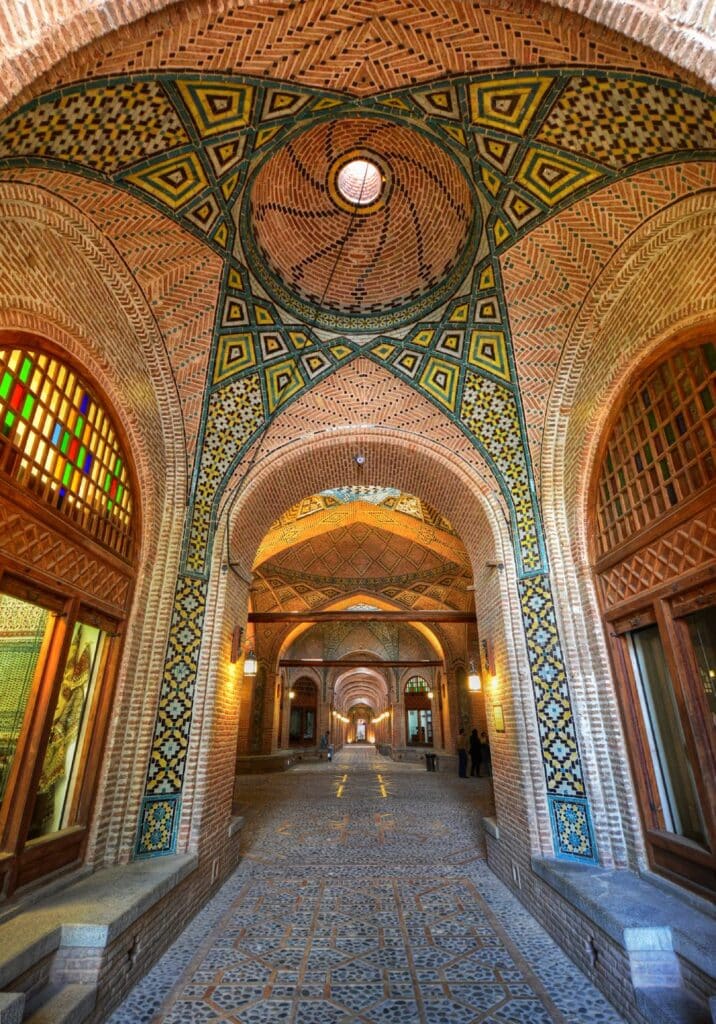
The Saʿadossaltaneh Caravanserai Complex is a grand architectural ensemble situated in the historic center of Qazvin. This sprawling complex, spanning a total area of 2.6 hectares, is a conglomeration of several caravanserais and sarās (courtyards). Unique in its structure, the complex is interconnected through arch-roofed bazaars and incorporates various other buildings like baths, mansions, shops, and Shotor-Khān (camel stables), functioning as a unified urban space. This ingenious design not only highlights the architectural grandeur of the caravanserais but also showcases the seamless integration of commercial and residential spaces, making it a bustling hub of activity in the city.
At the heart of this complex lies the main Saʿadossaltaneh Caravanserai, covering an impressive area of 8500 square meters. It features a large central courtyard of 3200 square meters, surrounded by four rows of chambers, totaling 34 in number. The caravanserai is distinguished by its four-Iwāns (porches) design, making it the largest and most significant part of the complex. The striking aesthetic of this building is defined by its brick domes, tile decorations, and intricate brickwork on the facades, which harmoniously blend with the skyline, creating a picturesque view. This architectural masterpiece serves not just as a historical monument but also as a living testament to the rich cultural and architectural heritage of Iran.
Moreover, the Saʿadossaltaneh Caravanserai is accessible through four entrances, each opening in a different direction. The north entrance leads to the street, the west to the Negar ol Saltaneh courtyard, the east to the Saadyeh courtyard, and the south entrance serves as a gateway to the Qeysariyeh and Bazaar. These multiple entrances not only facilitate easy access but also integrate the caravanserai into the urban fabric of Qazvin, making it an integral part of the city’s life and commerce.
Khān Caravanserai

The Khān Caravanserai represents a unique architectural approach in the design of Persian caravanserais, particularly in its Shotor-Khān (camel stable) layout. Unlike many traditional caravanserais where the Shotor-Khān is a separate or distinct structure, the Khān Caravanserai integrates it into the main building. This design feature is not commonly found in other caravanserais, making it a distinct example of Persian caravanserai architecture.
Furthermore, the Khān Caravanserai stands out for its intricate internal structure. It features a roomed Shotor-Khān on one side, which is a rare characteristic. This caravanserai combines a columned hall in the corners, along with long corridors behind the rooms, and includes a semi-open room. This complex layout provides a blend of open and enclosed spaces, adding to the functionality and aesthetic appeal of the caravanserai. Such architectural details highlight the innovative and adaptive nature of Persian caravanserai design, reflecting a blend of practicality and artistic expression.
Izadkhast Caravanserai
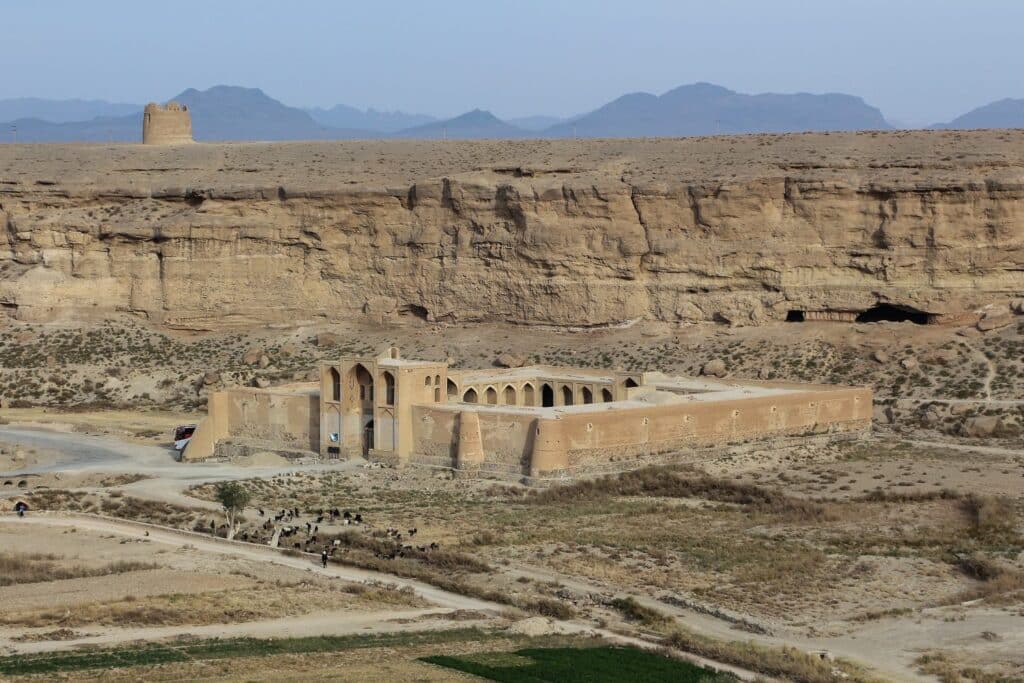
Izadkhast Caravanserai, a remarkable historical site, has a rich history and has undergone significant transformations. Originally used as an office building for a cultural heritage organization from 1945 to 1971, it has been continuously conserved and maintained. Registered in the National List in 1975, this caravanserai benefits from the protection and support of cultural heritage laws and regulations. Restoration and conservation efforts are coordinated by the IMCHTH in the Fars Provincial office.
The period between 2005 and 2019 marked a new chapter in the life of the Izadkhast Caravanserai. Extensive restoration and rehabilitation efforts during this time transformed it into an accommodation facility by 2019. These efforts included the restoration of roofs, lightening, and plastering by Kāhgel; strengthening repairs of interior and exterior brick walls; restoration of arches; and reinforcing the lower parts of external walls and towers. The revival of Rokhbām and re-bonding of old gypsum joints on the building’s exterior were also part of this restoration phase. This culminated in the initial stages of converting the caravanserai into a traditional hotel, marking a significant evolution in its function and offering a new way for visitors to experience this historic site.
Maranjab Caravanserai

Maranjab Caravanserai is a fascinating destination, rich in history and brimming with cultural significance. Situated in the heart of the Iranian desert, this caravanserai is a part of a network that includes Zeynoddīn, Amin Ābād, Mādar Shāh, and Mahyār, each with their unique stories. Maranjab, in particular, has been beautifully restored, preserving the architectural integrity and historical ambiance that make these sites so captivating. Today, it serves as a temporary lodging place and hostel, offering travelers an immersive experience in a traditional Persian setting.
The transformation of Maranjab Caravanserai into a modern accommodation facility is a brilliant example of preserving history while adapting to contemporary needs. Visitors can now stay overnight, experiencing the same routes once traveled by merchants and adventurers centuries ago. The blend of historical preservation and modern hospitality makes Maranjab not just a place to visit, but a journey back in time, offering a glimpse into the life and times of ancient Persian trade and travel.
Titi Caravanserai

Amidst the rugged Iranian landscape, the historic Titi Caravanserai stands as a testament to the nation’s vibrant past and its crucial role as a crossroads of trade and culture. This architectural marvel, hailing from the Safavid era, served as a vital stop for weary travelers and their caravans along the Silk Road.
As you explore Titi Caravanserai’s intricately designed courtyard adorned with stunning Persian tilework, you’ll uncover captivating tales from centuries ago. This oasis in Iran’s heart not only offers a glimpse into the nation’s history but also immerses travelers in the architectural charm of its past. As you venture deeper into its labyrinthine corridors, you’ll discover the rich history and significance of this cultural treasure. Whether you’re a history enthusiast or an adventurer looking to explore Iran’s hidden historical sites, Titi Caravanserai is a must-visit destination. Plan your journey with OrientTrips and embark on an unforgettable exploration of this remarkable site.
Vakil Caravanserai, Kerman

Located in the southern Iranian city of Kerman, Vakil Caravanserai stands as one of the world’s largest and most historic caravanserais. In ancient Iran, these caravanserais played a crucial role, offering weary long-distance travelers a place to rest and rejuvenate during their journeys. Constructed around 1870 under the orders of Mohammad Ismail Khan, the then-governor of Kerman, this architectural marvel boasts 120 rooms spread across two spacious floors.
The caravanserai’s grandeur is evident from its impressive façade adorned with meticulously crafted tiles, which extends to the outer porch. Notably, one of its standout features is the remarkable windshield, renowned for both its reputation and beauty. Moreover, the caravanserai boasts two entrances that open into the bustling Vakil market (Bazar-i Vakil), adding to its historical significance. Additionally, a captivating piece of history resides within the caravanserai in the form of a clock tower, with a storied journey of how it found its way to Iran. Vakil Caravanserai remains a captivating testament to Iran’s rich heritage and an essential stop for those exploring Kerman’s historical treasures.
Shah Abbasi Caravanserai, Bisotun

The Shah Abbasi Caravanserai in Bisotun, Kermanshah Province, Iran, is a captivating window into the nation’s storied past. This historical caravanserai, listed as an Iranian national heritage site since August 4, 1974, holds a special place in the hearts of history enthusiasts and travelers alike. Commissioned by the orders of Shah Abbas I, its construction stands as a testament to the grandeur of the Safavid era, with an inscription from Shah Suleiman further adding to its historical significance.
As you step into the Shah Abbasi Caravanserai, you’re transported to an era when it served as a vital hub for traders and travelers navigating ancient routes. Its architectural brilliance and well-preserved structure paint a vivid picture of the bustling activity that once thrived within its walls. The caravanserai’s courtyard, adorned with intricate details, bears witness to centuries of trade, culture, and the journeys of those who found shelter here. Whether you’re a history enthusiast or an intrepid explorer eager to uncover Iran’s past, Shah Abbasi Caravanserai in Bisotun is a must-visit destination. Plan your journey with OrientTrips and embark on a remarkable expedition into the enduring legacy of this extraordinary historical site.
Zafaraniyeh Caravanserai
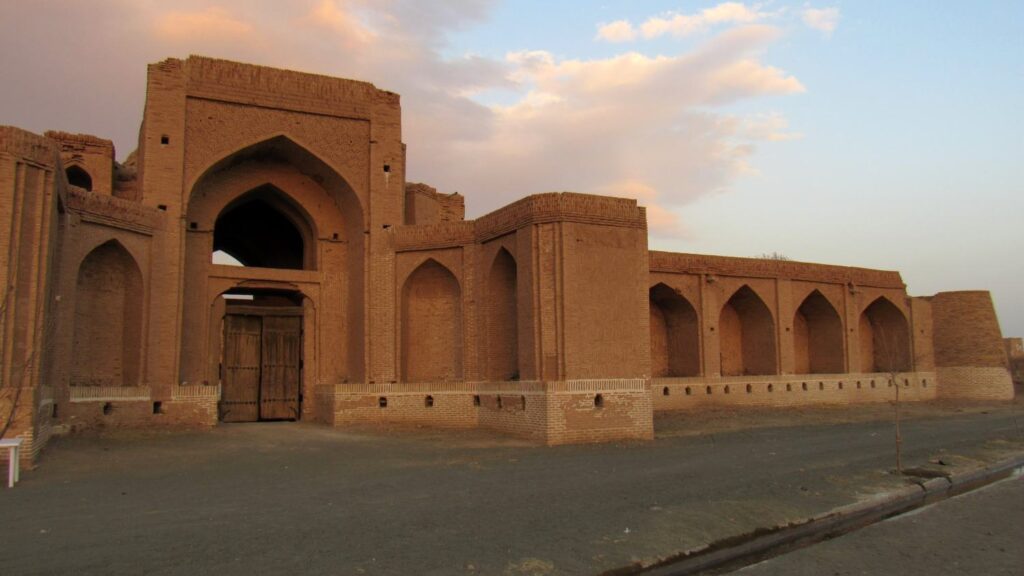
Zafaraniyeh Caravanserai, located in the Sabzevar County of Iran’s Razavi Khorasan Province, is a captivating glimpse into the nation’s rich heritage. This historical caravanserai, constructed during the Safavid and Qajar periods, holds a special place in Iran’s cultural tapestry and was officially registered as a national heritage site on December 17, 1985.
Built upon the remains of an earlier caravanserai from the Safavid and Seljuk eras, Zafaraniyeh Caravanserai features a central courtyard and surrounding stables in a four-iwan architectural style. Intricate decorations can be found in some of its alcoves. The overall plan displays rhythm, symmetry, and balance, with influences from Azari and Razi architectural styles evident in its brickwork.
The caravanserai’s name, Zafaraniyeh, is believed to originate from the use of saffron in its mortar instead of straw, as mentioned in James Justinian Morier’s travelogue. Other interpretations of the name’s origin also exist.
In a historic moment, on September 17, 2023, during the 45th session of the UNESCO World Heritage Committee held in Riyadh, Zafaraniyeh Caravanserai, along with 53 other historical caravanserais across 24 Iranian provinces, was inscribed as part of “Iranian Caravanserais” on the UNESCO World Heritage List. This global recognition marks Zafaraniyeh Caravanserai as the 27th world heritage site in Iran, highlighting its cultural and historical significance.
SURFIRAN Tours
Best Iran Tours
Caravanserais Today
Persian Caravanserais continue to be significant cultural and historical landmarks. They represent the rich historical tapestry of Persian architecture and trade history.
Many of these caravanserais have been preserved and maintained, showcasing their original design and structure.
Conservation Efforts
There are ongoing efforts to conserve and restore these historical structures. This includes structural maintenance, preserving architectural decorations, and preventing further deterioration.
Conservation activities are often supported by both national and provincial authorities in Iran.
Regular monitoring and documentation are part of the conservation strategy to ensure the integrity and authenticity of these sites.
Many of these caravanserais have been converted into hotels, offering a unique blend of historical ambiance and modern comfort. This transition not only preserves their architectural integrity but also allows visitors to experience the rich cultural heritage of Iran in a very personal way.
Modern Usage and Tourism
A notable example is the Abbasi Caravanserai in Isfahan. Originally built during the Safavid era, this caravanserai has been meticulously restored and transformed into the Abbasi Hotel. The hotel retains much of its original architecture, including the magnificent central courtyard, and is renowned for its intricate Persian artwork and luxurious settings.
Another prominent example is the Zein-o-Din Caravanserai. The Zein-o-Din Caravanserai, located near Yazd in Iran, is a splendid example of Persian caravanserai architecture and a testament to the rich history of the Silk Road. This caravanserai, dating back to the Safavid era, is particularly notable for its distinctive circular design, a rarity among the more commonly rectangular or square Persian caravanserais.

Architecturally, the Zein-o-Din Caravanserai is a marvel. Its circular structure creates a unique and harmonious appearance, and the central courtyard, traditionally used for gatherings and as a resting place for travelers and their animals, remains a focal point of the design. The caravanserai is built with thick mud-brick walls, which provide excellent insulation against the desert heat and cold, and features a series of intricately designed iwans (porches) and rooms that surround the courtyard.
Historically, the Zein-o-Din Caravanserai served as a secure stopover for travelers and traders on the Silk Road. It offered not only a place to rest but also protection from potential threats in the vast desert. Today, it has been thoughtfully restored and converted into a hotel, allowing visitors to immerse themselves in the history and ambiance of the Silk Road era.
Staying at the Zein-o-Din Caravanserai is a journey into the past. The preservation of its original architectural elements, combined with the addition of modern comforts, offers a unique experience. Visitors can enjoy the star-filled night skies of the desert, the traditional Persian cuisine, and the hospitality that caravanserais have been known for over centuries.
The Zein-o-Din Caravanserai is not just a historical monument; it’s a living bridge to Iran’s illustrious past, continuing to welcome travelers from around the world, much like it did hundreds of years ago.
The Saraye Ameriha Boutique Hotel in Kashan is another remarkable transformation. This historic house, once a caravanserai, has been converted into a luxurious hotel. It combines traditional Persian architecture with modern amenities, offering a unique blend of history and luxury.
These examples demonstrate how Persian caravanserais have evolved from ancient roadside inns to modern-day hotels, preserving their historical essence while providing unique experiences for travelers and history enthusiasts.
Conclusion: The Legacy of Persian Caravanserais
The legacy of Persian caravanserais is deeply embedded in the historical and cultural fabric of Iran. These architectural marvels, once the lifelines of the Silk Road, have transcended their original purpose to become symbols of Iran’s rich heritage and a testament to its architectural prowess. The intricate designs, robust structures, and the stories they carry, bridge the past with the present, offering a unique glimpse into the life and times of ancient travelers and traders.
Their Role in Contemporary Society
In contemporary society, Persian caravanserais have found new life and relevance. Many have been transformed into hotels, museums, and cultural centers, thereby preserving their historical essence while adapting to modern needs. They serve not only as tourist attractions but also as educational sites where people can learn about Iran’s history, architecture, and the significance of the Silk Road.
These caravanserais also play a vital role in the local economy, generating tourism revenue and providing employment opportunities. They have become meeting points for cultural exchange, where visitors from around the world can experience Iranian hospitality and traditions firsthand.





